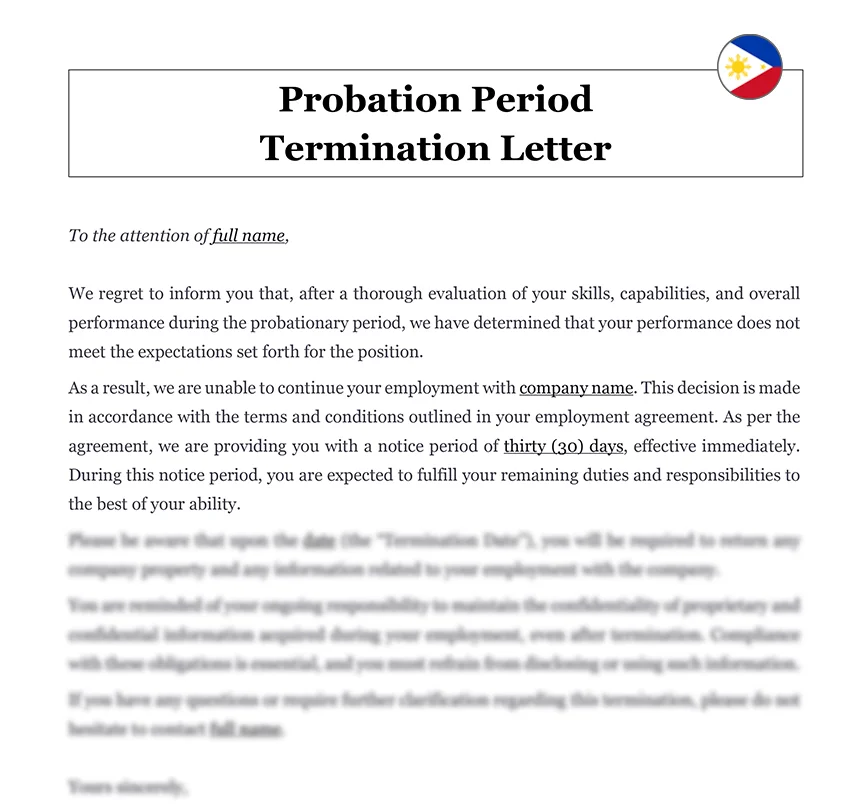Ready to use legal template
Drafted by experienced lawyers
Compliant with Filipino law
Ready to use legal template
Drafted by lawyers
Compliant with Filipino law
Learn more about Probation Period Termination in Philippines
Implementing an Employee Probation Period Termination policy in the Philippines is a strategic marketing decision that reinforces a commitment to excellence and customer satisfaction. By setting clear expectations and performance standards during the probationary period, businesses can ensure that only qualified and dedicated employees become part of their team. This policy allows for timely assessment of employee performance and suitability for the role, ensuring that the company delivers exceptional products or services to its customers. By terminating employees who do not meet the required standards, businesses can uphold their brand’s reputation for excellence and maintain a high level of customer satisfaction.
Table of contents
-
What is an Employee Probation Period Termination?
-
What are the legal considerations when terminating an employee in the Philippines?
-
What are the employee rights during the probation period?
-
What are the employer's responsibilities when terminating on probation?
-
What are the steps for terminating an employee during the probation?
-
How are disputes related to employee probation period termination?
What is an Employee Probation Period Termination?
In the Philippines, an employee probation period termination refers to the act of ending the employment of an employee who is still under probation. During the probationary period, which typically lasts for a specified duration as defined by the employer, both the employer and the employee assess each other’s suitability for continued employment. The probation period allows the employer to evaluate the employee’s performance, skills, and overall fit within the organization.
Probationary employment is governed by the Philippine Labor Code, which provides certain rights and protections for both employers and employees. However, unlike regular employees who enjoy stronger job security, probationary employees have a more limited scope of protection under the law.
During the probation period, employers have the authority to terminate the employment of a probationary employee for various reasons, including poor performance, misconduct, or a mismatch between the employee’s skills and the job requirements. However, it is crucial for employers to ensure that the grounds for termination are valid and supported by evidence to avoid potential legal complications. From the employee’s perspective, probationary employment provides an opportunity to showcase their skills and prove their suitability for the position. It is a critical phase where employees strive to meet performance expectations, demonstrate their capabilities, and secure a permanent position within the company.
What are the legal considerations when terminating an employee in the Philippines?
When terminating an employee during the probation period in the Philippines, several legal considerations must be taken into account. The first important consideration is compliance with labor laws and regulations. The employer must ensure that the termination is not discriminatory or based on any prohibited grounds, such as gender, religion, or disability.
Additionally, the employer should review the terms and conditions stated in the employment contract, specifically regarding the probation period and the grounds for termination. It is crucial to follow the agreed-upon procedures and provide sufficient notice or compensation, if applicable.
Furthermore, the employer should adhere to due process requirements. This includes giving the employee the opportunity to be heard, providing clear reasons for termination, and documenting the performance issues or misconduct that led to the decision in the Employment Termination Letter. By following these legal considerations, employers can minimize the risk of legal disputes or claims arising from probationary period termination.
What are the employee rights during the probation period?
Employees in the Philippines, even during the probationary period, are entitled to certain rights and protections. These rights include fair treatment, non-discrimination, and the right to receive wages and benefits as agreed upon in the employment contract. Employees should be provided with a safe and healthy working environment, and their privacy should be respected.
During the probation period, employees also have the right to receive regular feedback and guidance from their employer regarding their performance. If the employer decides to terminate the employee’s probationary employment, they should provide clear reasons for the termination and ensure that the decision is based on valid and objective grounds.
It’s important to note that while employees have these rights and protections, the scope and extent may differ from those provided to regular or permanent employees. The probationary period serves as a period of assessment for both the employer and the employee to determine if the working relationship is a good fit.
What are the employer's responsibilities when terminating on probation?
Employers have specific rights and responsibilities when terminating an employee on probation. During the probationary period, the employer has the right to assess the employee’s performance, competence, and suitability for the job. If the employer determines that the employee is not meeting the required standards, they have the right to terminate the employment contract.
However, it is the employer’s responsibility to ensure that the termination is done in accordance with labor laws and the terms agreed upon in the employment contract. This includes providing clear reasons for the termination, following the agreed-upon procedures, and giving the employee the opportunity to be heard.
The employer also has the responsibility to provide feedback and guidance to the employee during the probation period. This can help the employee understand the areas where improvement is needed and give them a fair chance to meet the employer’s expectations.
What are the steps for terminating an employee during the probation?
Step 1. Review the employment contract
Familiarize yourself with the terms and conditions of the employment contract, including any provisions related to the probation period and termination.
Step 2. Document performance issues
Keep a record of any performance issues or misconduct observed during the probation period. This documentation will serve as evidence to support the decision to terminate the employee.
Step 3. Provide feedback and guidance
Offer regular feedback and guidance to the employee during the probation period. Clearly communicate expectations and areas for improvement, giving the employee an opportunity to address any shortcomings.
Step 4. Notify the employee
Schedule a meeting with the employee to discuss the termination decision. Clearly communicate the reasons for termination, referring to the documented performance issues or misconduct. Provide the employee with an opportunity to respond and ask questions.
Step 5. Follow due process
Ensure that the termination process adheres to due process requirements. This includes giving the employee the opportunity to be heard, providing a reasonable amount of notice or compensation as per the employment contract, and complying with any applicable legal provisions.
Step 6. Issue a termination letter
Prepare a written termination letter that outlines the reasons for termination, the effective date of termination, and any applicable post-termination benefits or obligations.
Step 7. Conduct exit procedures
Complete any necessary exit procedures, such as collecting company property from the employee and finalizing paperwork related to termination.
Step 8. Offer support and assistance
While terminating an employee is a difficult process, it is important to offer support and assistance to the employee during the transition. Provide information on any available resources or assistance programs that can help them find new employment opportunities.
By following these steps, employers can ensure a fair and lawful termination process during the probation period in the Philippines. It is crucial to consult with lawyers or human resources experts to ensure compliance with all applicable laws and regulations.
How are disputes related to employee probation period termination?
In the Philippines, disputes and legal issues related to employee probation period termination are typically handled through established legal procedures and mechanisms. Here are some key points to consider:
1. Mediation and conciliation: In cases of disputes arising from employee probation period termination, parties involved can choose to engage in mediation or conciliation. This involves the assistance of a neutral third party who helps facilitate communication and negotiation to reach a mutually agreeable resolution.
2. Department of Labor and Employment (DOLE): If mediation or conciliation efforts are unsuccessful, either party can file a complaint or seek assistance from the DOLE. The DOLE has various offices, such as the National Labor Relations Commission (NLRC), which handles labor-related disputes, including those arising from employee termination.
3. Filing a complaint: The aggrieved party may file a formal complaint with the NLRC or the appropriate regional office of the DOLE. This initiates a legal process where both parties present their arguments and evidence before the labor authorities.
4. Labor Arbitration: In some cases, unresolved disputes may be referred to labor arbitration. An arbitrator, appointed by the NLRC or a designated labor arbiter, hears the case and makes a binding decision.
5. Court litigation: If the dispute remains unresolved after exhausting administrative remedies, either party may choose to file a case in the appropriate court. This typically happens when there are violations of labor laws or contractual provisions that require legal intervention.
ℹ️ In the case that the employee performance evaluation does not result in improvements that could lead to a warning or dismissal, it is possible to use the Employee Termination Letter and Employee Warning Letter to guarantee protection for your company.
SPECIAL OFFER
HR Pro
15 Document Package
Essential documents for managing employees in the Philippines
Employee Probation Period TerminationTemplate (.docx)
Save on attorney fees
310 client reviews (4.8/5) ⭐⭐⭐⭐⭐
Share information
Why Themis Partner ?
Make documents forhundreds of purposes
Hundreds of documents
Instant access to our entire library of documents for Philippines.
24/7 legal support
Free legal advice from our network of qualified lawyers.
Easily customized
Editable Word documents, unlimited revisions and copies.
Legal and Reliable
Documents written by lawyers that you can use with confidence.




